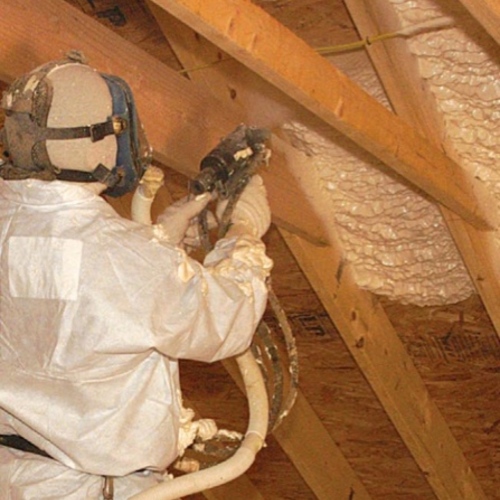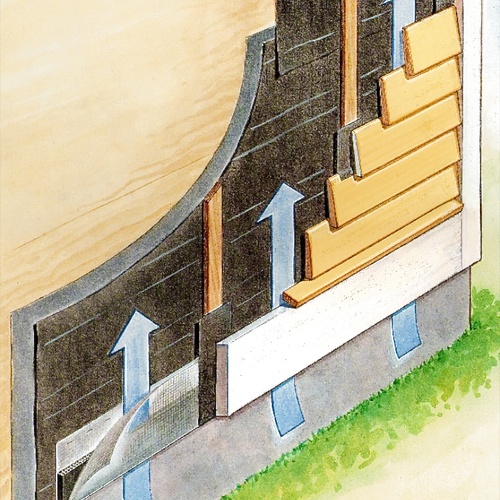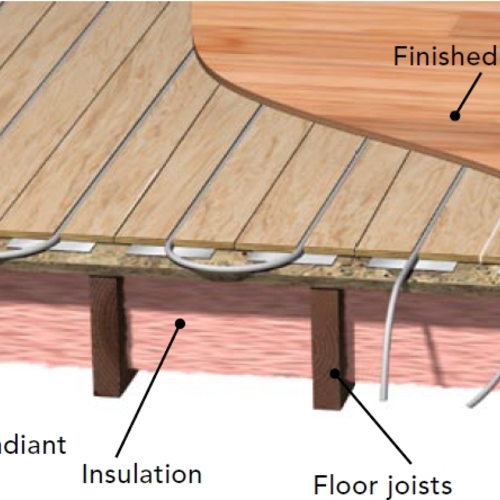
It feels that the focus in green building is on new homes being built to Passive House standards or the like. There’s a lot to be learned there, but it’s top-of-the-pyramid stuff. Most builders don’t work at that level. Certainly, most of the work my partner and I do isn’t there. We work largely on old buildings. Faced with the realities of time and budget, we do what we can.
We just had a job spray-foamed. It was an old barn with irregularly spaced framing. Most other kinds of insulation would have been a lot more difficult. We stapled housewrap to the back of the siding and the edges of the timber frame. In doing so, we worked from the top down in a mirror image of how you’d install housewrap from the outside. That created the necessary shingle-style lap on the outer face of the housewrap. The housewrap kept the foam from oozing out through the cracks in the old vertical siding, made replacing pieces of siding down the road a lot easier, and made the insulation of this circa-1795 barn reversible.
We were only able to get 3 in. to 4 in. of closed-cell foam in the walls, but at R-6 per in., that meant a solid R-18 to R-24, plus air-sealing. The contractor used one of the new blowing agents with a global warming potential equivalent to CO2, so the carbon debt of the insulation will be repaid quickly.
Just what are the nuances?
Still, compared to what we know is possible, our wall insulation is anemic for zone 5. In an effort to find out just which level of green-building Hell we are destined for, I began to wonder just how much of a difference relatively minor amounts of insulation make. This thinking…
Weekly Newsletter
Get building science and energy efficiency advice, plus special offers, in your inbox.

This article is only available to GBA Prime Members
Sign up for a free trial and get instant access to this article as well as GBA’s complete library of premium articles and construction details.
Start Free TrialAlready a member? Log in















5 Comments
A great reminder that not every job can be a Passiv Spaceship and theres value in incremental gains.
Nice column; agree that compromises between budget, space, and performance definitely make sense! It's like what Martin and others write about Passive House insulation levels--which provides greater good for the world--12 inches of insulation under a PH slab, or 2 inches under 6 houses?
One nit-picky geeky thing to correct in the column:
going from the basic R-value of 2 to an R-8 nets a decrease in annual energy flow (or loss) from 53 mm/Btu to 14 mm/Btu. That R-6 of insulation equates to an inch of spray foam.
The correct nomenclature is "MMBtu," which means million Btu, as Allison Bailes has on his graph. What you have written could be misinterpreted as 'millimeters per Btu' or similar.
The whole MMBtu terminology is a bit nuts--nope, it's not the metric "k" = kilo = 1000 and "M" = mega = 1,000,000. It is Roman M (1000) x M (1000) = 1,000,000. Uggggh. I blame the British empire. ;)
https://en.wikipedia.org/wiki/British_thermal_unit
The unit MBTU is used in natural gas and other industries to indicate 1,000 BTUs.[11][12] However, there is an ambiguity in that the metric system (SI) uses the prefix "M" to indicate one million (1,000,000), and consequently "MMBtu" is often used to indicate one million BTUs.[13]
Energy analysts accustomed to the metric "k" for 1,000 are more likely to use MBtu to represent one million, especially in documents where M represents one million in other energy or cost units, such as MW, MWh and $.
This is the sort of thing that us shoemaker's children's parents do all the time. Knowledge gained here on GBA helps us di it in a way that won't cause trouble later on. Also what is the r value of mouse nests? Asking for a friend.
The R-value of the mouse nest is the same as the insulation material they used to build it. The R-value of mouse poop is much lower, so you have to reduce the overall R-value by the volumetric ratio of poop to insulation in the nesting material. This is all included in the WUFI user guides...
So there's an air gap between the polyiso in the rafters and the roof sheathing? I ask because it seems like most things I've read on here lead me to believe that the interior insulating material should be adhered directly to the sheathing. Our ranch has a vaulted, post-and-beam like living room ceiling where the underside of the 2x6 sheathing is the finished ceiling and I am trying to figure out how to insulate it without closed-cell foam that won't cause problems down the road. Thanks in advance for the response. Bill
Log in or become a member to post a comment.
Sign up Log in